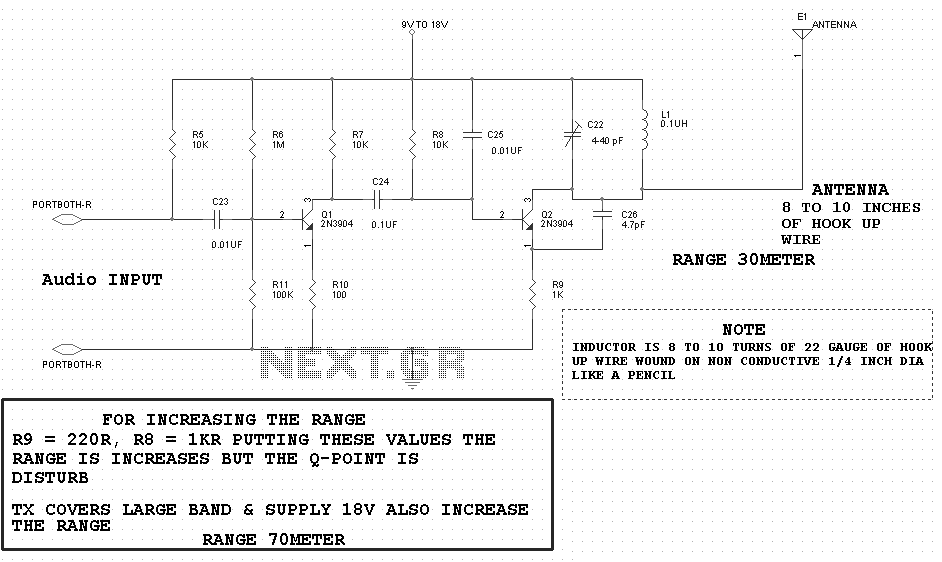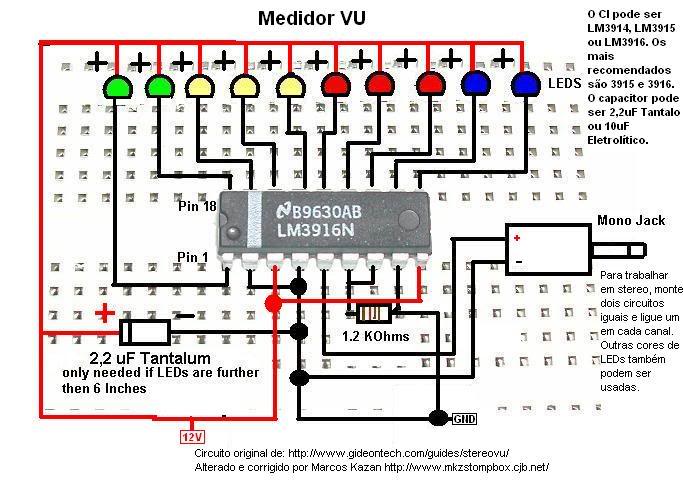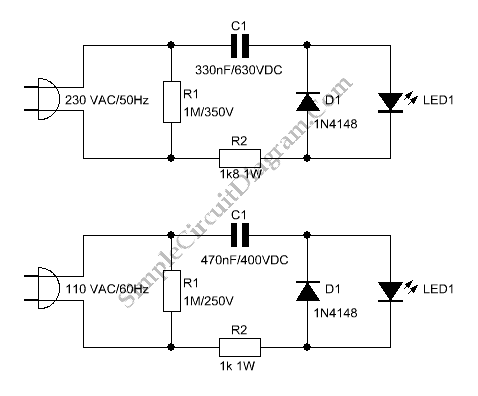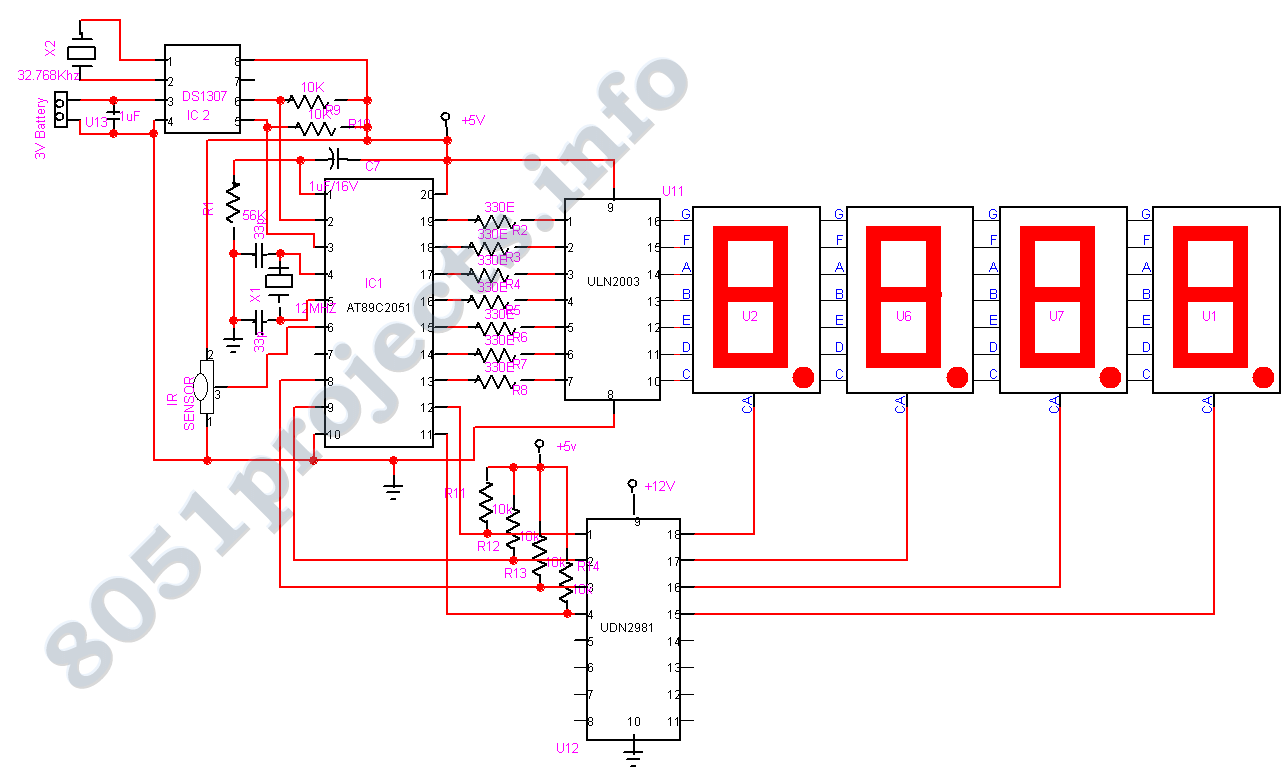
Led Running Lights

The circuit comprises three main components. The first component features an oscillator, while the second component includes a mod 16 counter (7493). The oscillator is configured in self-triggered mode, and a potentiometer (VR1) is utilized for speed control of the running lights, allowing frequency variation from 21 Hz to below 1 Hz. The counter outputs A, B, and C are decoded by IC3 (decoder 7442), with outputs available on pins 1 to 9 of this integrated circuit. The D output of the counter is responsible for selecting the LEDs from D1 to D8 or D9 to D16. When the D output is low, LEDs D1 to D8 are activated; when high, LEDs D9 to D16 are activated. A NAND gate (IC4, 7400) is employed for the selection of these LEDs, resulting in a sequential running effect.
The circuit design can be divided into three distinct functional blocks: the oscillator, the mod 16 counter, and the LED driver section.
The oscillator is designed to operate in a self-triggered mode, which ensures continuous operation without the need for an external clock signal. The frequency of oscillation can be adjusted using the variable resistor (VR1), allowing for a broad range of frequencies. This feature is particularly useful for applications requiring dynamic light effects, as it enables the user to fine-tune the speed of the running lights.
The mod 16 counter (7493) serves as the core counting mechanism, producing binary outputs corresponding to its count value. The outputs A, B, and C are directly connected to the decoder IC3 (7442), which converts the binary count into a decimal output. The decoder outputs are available on pins 1 to 9, which can drive multiple LEDs, providing visual feedback of the counter's state.
The D output of the counter plays a crucial role in determining which set of LEDs is illuminated. The circuit is designed such that when the D output is low, it activates the first set of LEDs (D1 to D8). Conversely, when the D output is high, the second set of LEDs (D9 to D16) is activated. This dual selection mechanism allows for a more extensive range of visual effects.
The NAND gate (IC4, 7400) is utilized to facilitate the selection process of the LEDs. This gate effectively manages the logic required to switch between the two groups of LEDs based on the state of the D output from the counter. The result is a visually appealing sequential running light effect, where the LEDs light up in a predetermined sequence, creating an engaging display.
Overall, this circuit exemplifies a practical application of digital electronics, combining oscillation, counting, and LED driving techniques to achieve a dynamic and adjustable lighting effect.The circuit consists of three parts. The first part has an oscillator while the second has mod 16 counter 7493. The oscillator is wired in self-triggered mode, and the potentiometer VR1 is used for speed control of the running lights. That is, frequency can be varied from 21 Hz to less than 1 Hz. The counter outputs A, B and C are decoded by IC3 (t he decoder 7442) and the outputs obtained on pins 1 to 9 of this IC. The D output of the counter is used for selecting the LEDs from D1 to D8 or D9 to D16. When D is low D1 to D8 are selected, and when D is high D9 to D16 are selected. For the selection of these LEDs, IC4 (7400) NAND gate is used. Thus, a sequential running effect is produced. 🔗 External reference
The circuit design can be divided into three distinct functional blocks: the oscillator, the mod 16 counter, and the LED driver section.
The oscillator is designed to operate in a self-triggered mode, which ensures continuous operation without the need for an external clock signal. The frequency of oscillation can be adjusted using the variable resistor (VR1), allowing for a broad range of frequencies. This feature is particularly useful for applications requiring dynamic light effects, as it enables the user to fine-tune the speed of the running lights.
The mod 16 counter (7493) serves as the core counting mechanism, producing binary outputs corresponding to its count value. The outputs A, B, and C are directly connected to the decoder IC3 (7442), which converts the binary count into a decimal output. The decoder outputs are available on pins 1 to 9, which can drive multiple LEDs, providing visual feedback of the counter's state.
The D output of the counter plays a crucial role in determining which set of LEDs is illuminated. The circuit is designed such that when the D output is low, it activates the first set of LEDs (D1 to D8). Conversely, when the D output is high, the second set of LEDs (D9 to D16) is activated. This dual selection mechanism allows for a more extensive range of visual effects.
The NAND gate (IC4, 7400) is utilized to facilitate the selection process of the LEDs. This gate effectively manages the logic required to switch between the two groups of LEDs based on the state of the D output from the counter. The result is a visually appealing sequential running light effect, where the LEDs light up in a predetermined sequence, creating an engaging display.
Overall, this circuit exemplifies a practical application of digital electronics, combining oscillation, counting, and LED driving techniques to achieve a dynamic and adjustable lighting effect.The circuit consists of three parts. The first part has an oscillator while the second has mod 16 counter 7493. The oscillator is wired in self-triggered mode, and the potentiometer VR1 is used for speed control of the running lights. That is, frequency can be varied from 21 Hz to less than 1 Hz. The counter outputs A, B and C are decoded by IC3 (t he decoder 7442) and the outputs obtained on pins 1 to 9 of this IC. The D output of the counter is used for selecting the LEDs from D1 to D8 or D9 to D16. When D is low D1 to D8 are selected, and when D is high D9 to D16 are selected. For the selection of these LEDs, IC4 (7400) NAND gate is used. Thus, a sequential running effect is produced. 🔗 External reference
Warning: include(partials/cookie-banner.php): Failed to open stream: Permission denied in /var/www/html/nextgr/view-circuit.php on line 713
Warning: include(): Failed opening 'partials/cookie-banner.php' for inclusion (include_path='.:/usr/share/php') in /var/www/html/nextgr/view-circuit.php on line 713





